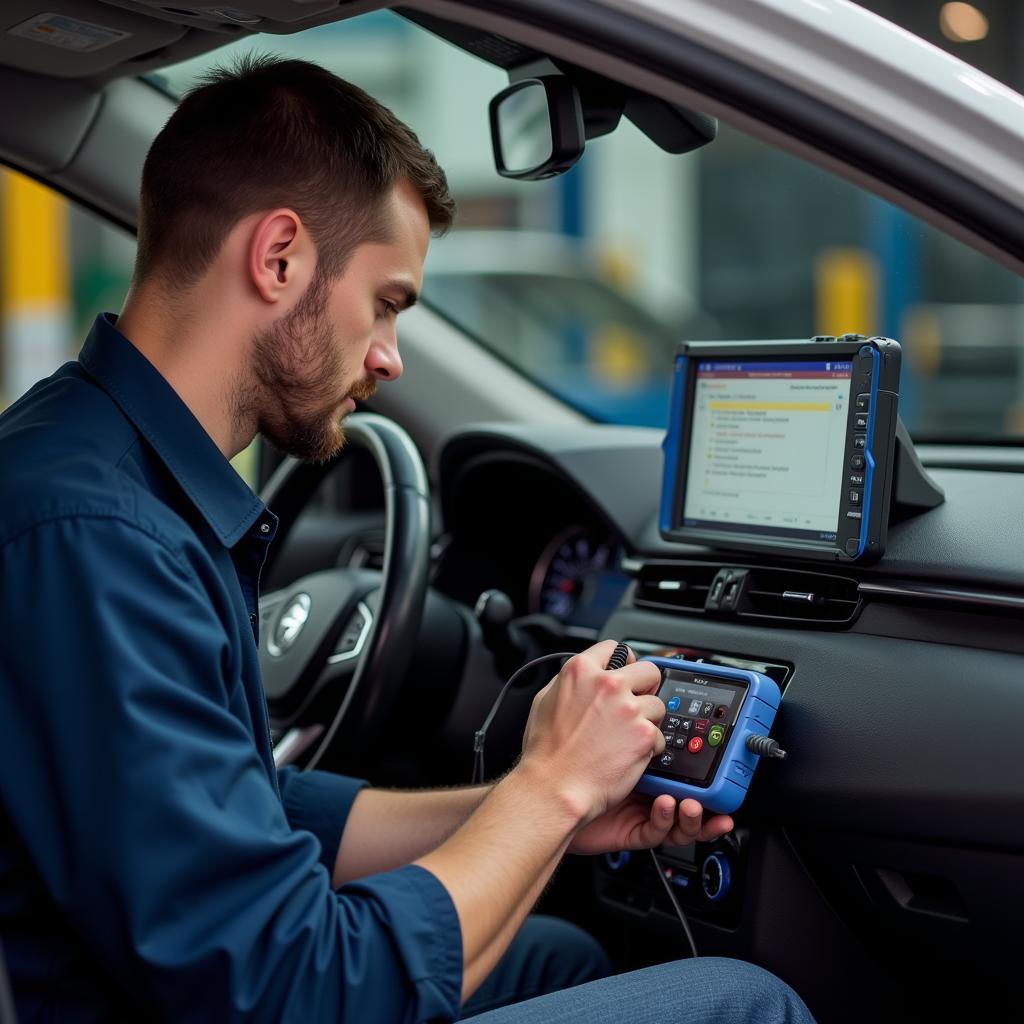Delphi Car Diagnostic Codes are essential for mechanics and car owners alike to troubleshoot and repair modern vehicles. These alphanumeric codes, generated by your car’s onboard computer system, act as clues pointing to potential issues within your vehicle’s engine, transmission, emissions system, and more. This guide delves deep into the world of Delphi car diagnostic codes, providing you with the knowledge to understand their meaning and how to use them effectively.
 Delphi Diagnostic Tool Connected to Car
Delphi Diagnostic Tool Connected to Car
What are Delphi Car Diagnostic Codes?
When your car’s “Check Engine” light illuminates, it’s a signal that your car’s computer has detected a potential problem. This problem is registered as a diagnostic trouble code (DTC) within the system. Delphi, a leading provider of automotive diagnostic equipment, offers tools specifically designed to read and interpret these codes, helping you pinpoint the root cause of the issue.
These codes follow a standardized format, often starting with a letter:
- P: Powertrain (Engine, Transmission, Emissions)
- B: Body (Airbags, Power Seats, Central Locking)
- C: Chassis (ABS, Traction Control, Suspension)
- U: Network & Communication (Modules, Wiring)
The letter is followed by four digits, each with a specific meaning related to the system and the nature of the problem.
Why are Delphi Car Diagnostic Codes Important?
Imagine trying to solve a puzzle without all the pieces. That’s essentially what diagnosing a car problem is like without understanding diagnostic codes. These codes provide valuable insights for:
- Accurate Diagnosis: Eliminate guesswork and pinpoint the exact area requiring attention.
- Efficient Repairs: Knowing the specific issue allows for targeted repairs, saving time and potentially costly trial-and-error.
- Preventive Maintenance: Some codes may indicate minor issues before they escalate into major problems, allowing for proactive maintenance.
How to Read and Interpret Delphi Codes
While Delphi offers sophisticated diagnostic tools like the Delphi DS150E, even basic code readers can retrieve codes from your vehicle. Once you have a code, you can:
- Consult a Reliable Source: Utilize online databases, repair manuals, or dedicated Delphi software to look up the code’s meaning.
- Understand the Severity: Codes often indicate a range of issues, from minor sensor malfunctions to serious engine problems. The source you consult should provide details on potential severity.
- Don’t Jump to Conclusions: A code is a starting point. Further investigation and testing may be necessary to confirm the diagnosis and rule out related problems.
 Mechanic Using a Delphi Scanner Under a Car’s Dashboard
Mechanic Using a Delphi Scanner Under a Car’s Dashboard
Common Delphi Car Diagnostic Codes
Here are some examples of commonly encountered Delphi car diagnostic codes:
- P0420: Catalyst System Efficiency Below Threshold (Bank 1) – This code often indicates a failing catalytic converter.
- P0171: System Too Lean (Bank 1) – This could mean a vacuum leak, faulty oxygen sensor, or fuel delivery problem.
- P0300: Random/Multiple Cylinder Misfire Detected – This signifies engine misfires, which could be caused by spark plugs, ignition coils, or fuel injectors.
- U0100: Lost Communication with ECM/PCM – This code indicates a communication error between the engine control module (ECM) and other modules.
For a more comprehensive list of Delphi diagnostic codes, you can refer to our dedicated resources: Delphi DS150E Cars Diagnostic.
The Importance of Professional Diagnostics
While obtaining and interpreting Delphi car diagnostic codes can provide a good starting point, it’s important to remember that they are just one piece of the puzzle. A professional mechanic with experience in using OEM car diagnostic tools can utilize these codes along with visual inspections, mechanical tests, and their expertise to ensure an accurate diagnosis and effective repair.
Conclusion
Delphi car diagnostic codes are invaluable tools for understanding and resolving vehicle issues. By familiarizing yourself with these codes and seeking professional assistance when needed, you can keep your car running smoothly and avoid costly repairs. Remember, a well-maintained car is a safe and reliable car.
FAQs
1. Can I clear Delphi codes myself?
Yes, you can clear codes using a diagnostic tool. However, this will not fix the underlying issue and the code will return if the problem persists.
2. Are Delphi codes universal?
While there are some standardized codes, manufacturers may have their own specific codes.
3. How often should I get a car diagnostic check?
It is recommended to have a professional diagnostic check at least once a year or as part of your regular maintenance schedule.
4. Can I use a Delphi diagnostic tool on any car?
Delphi tools are compatible with a wide range of vehicles. However, it’s essential to check compatibility before purchasing or using the tool.
5. Do I need special software to use a Delphi diagnostic tool?
Some advanced features of Delphi tools may require dedicated software.
Don’t hesitate to contact us for all your car diagnostic needs!
WhatsApp: +1(641)206-8880
Email: [email protected]
We have a 24/7 customer support team ready to assist you.

Leave a Reply